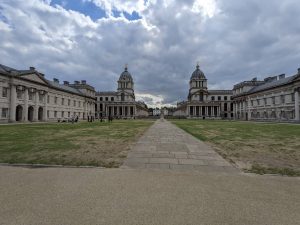 Waterloo 2022: prelude only really came about because I live on the Isle of Man. My much anticipated Waterloo tour officially starts in London with dinner on 1st September, but given the unpredictable nature of travel these days, I was absolutely determined not to risk a major delay. Accordingly I found myself in London with a whole day to spare yesterday.
Waterloo 2022: prelude only really came about because I live on the Isle of Man. My much anticipated Waterloo tour officially starts in London with dinner on 1st September, but given the unpredictable nature of travel these days, I was absolutely determined not to risk a major delay. Accordingly I found myself in London with a whole day to spare yesterday.
Some people – those with sense – would have found something relaxing to do ahead of what is likely to be an energetic tour. I decided the best way to spend the day was on a marathon tour around the navy museums in Greenwich, before going for dinner with some of my fellow travellers. I was absolutely shattered but had a great deal of fun.
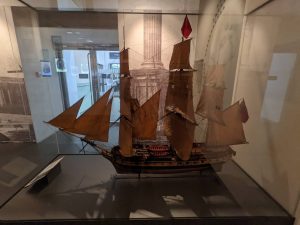 The National Maritime Museum part of Royal Museums Greenwich, a network of museums in the Maritime Greenwich World Heritage Site. Greenwich has always had connections with the sea and navigation. There was a Roman landing place here, the Navy has a long history with the Greenwich waterfront and in 1675, Charles II founded the Royal Observatory for “finding the longitude of places” Greenwich has been the home of Greenwich Mean Time and the Prime Meridian since 1884, and has been a centre for astronomical study. Navigators right across the world have set their clocks according to its time of day. It’s the perfect place for a maritime museum.
The National Maritime Museum part of Royal Museums Greenwich, a network of museums in the Maritime Greenwich World Heritage Site. Greenwich has always had connections with the sea and navigation. There was a Roman landing place here, the Navy has a long history with the Greenwich waterfront and in 1675, Charles II founded the Royal Observatory for “finding the longitude of places” Greenwich has been the home of Greenwich Mean Time and the Prime Meridian since 1884, and has been a centre for astronomical study. Navigators right across the world have set their clocks according to its time of day. It’s the perfect place for a maritime museum.
The Museum has a fantastic collection on the history of Britain at sea including both British and Dutch maritime art, cartography, manuscripts ship models and plans, scientific and navigational instruments. There are a series of galleries looking at the history of Britain at sea, organised either geographically or by historic period.
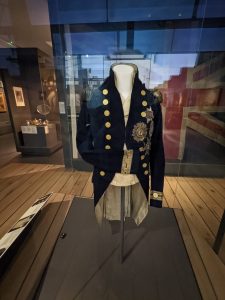 There is, as usual, an abundance of information and artefacts about Lord Nelson, England’s most feted naval hero including the clothing he was wearing when he was shot down on the deck of the Victory during the Battle of Trafalgar. While I’m grateful that the national obsession with Nelson means that EVERY navy museum has something relating to my period of interest, I can’t help imagining the howls of indignation of a few other navy officers of the era who really did some quite impressive stuff themselves, but don’t get a mention. Nevertheless, the National Maritime Museum is fascinating, with loads to see and do for both adults and children and I highly recommend it.
There is, as usual, an abundance of information and artefacts about Lord Nelson, England’s most feted naval hero including the clothing he was wearing when he was shot down on the deck of the Victory during the Battle of Trafalgar. While I’m grateful that the national obsession with Nelson means that EVERY navy museum has something relating to my period of interest, I can’t help imagining the howls of indignation of a few other navy officers of the era who really did some quite impressive stuff themselves, but don’t get a mention. Nevertheless, the National Maritime Museum is fascinating, with loads to see and do for both adults and children and I highly recommend it.
Close by is the old Royal Naval College, the centrepiece of what has come to be known as Maritime Greenwich. The buildings were originally built as the Royal Hospital for Seamen at Greenwich, first chartered by King William III and Queen Mary II in 1694. The buildings were designed by Christopher Wren and built between 1696 and 1712. The hospital closed in 1869 and between 1873 and 1998 it was the Royal Naval College, Greenwich.
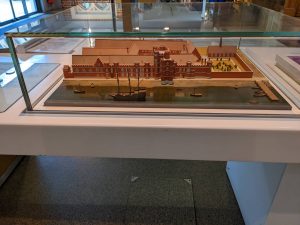
There had been a palace on this site from the days of Humphrey, Duke of Gloucester. It was rebuilt by Henry VII and became known as Greenwich Palace, a favourite residence of several Tudor monarchs. Henry VIII, Mary I and Elizabeth I were all born there. It remained a royal palace until it fell into disrepair during the Civil Wars of the seventeenth century and was finally demolished in 1694.
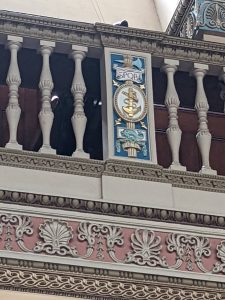 Greenwich Seaman’s Hospital was built on the orders of Mary II who was affected by the sight of wounded sailors coming home from the Battle of La Hogue. It is incredibly beautiful architecturally and both the Chapel and the Painted Hall are well worth a visit. I particularly liked the Chapel, which has naval motifs incorporated into the design.
Greenwich Seaman’s Hospital was built on the orders of Mary II who was affected by the sight of wounded sailors coming home from the Battle of La Hogue. It is incredibly beautiful architecturally and both the Chapel and the Painted Hall are well worth a visit. I particularly liked the Chapel, which has naval motifs incorporated into the design.
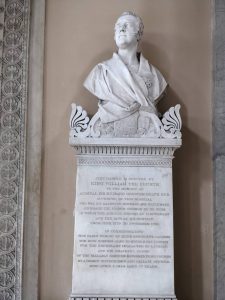
Even so, I will admit that for me the most exciting part of that visit was to spot a bust of Admiral Sir Richard Keats, looking benignly at me from a corner. Keats is a recurring character in my Manxman series and it was like running into an old friend, though I probably confused the rest of the tour group with my enthusiasm. Nobody had heard of him and I promise I only gave a gratuitous chunk of information in revenge for somebody asking me if he would have known Nelson…
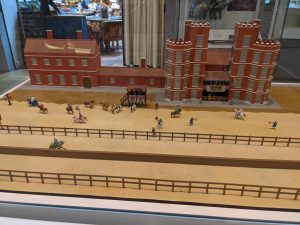
There’s a modern visitor centre which is really interesting on the subject of the early history of the Greenwich site, including models of the the old palace and the tilt yard established there by Henry VIII.
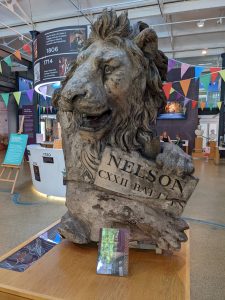 Nelson also features a fair bit, surprisingly enough. England’s Hero lay in state for several days in the Painted Hall and there is a small dedicated Nelson Room, but my favourite artefact is a lion which was apparently a model piece for the Nelson frieze. The lion is holding a stone which purports to claim that Nelson fought in 122 battles. I had this piece of information from the guide and I’ve not managed to check it at all, but my extensive reading on the subject of the Napoleonic navy so far has suggested that most of the time was spent either on tedious blockade duty or seething at home on half-pay. Nobody seemed able to answer my question about how Nelson managed to see quite so much action during his time in the navy but if I get to the bottom of it, I’ll let you know. Alternatively, if anybody else knows where I can find a list of these battles, I’d love to hear it. Nice lion, though.
Nelson also features a fair bit, surprisingly enough. England’s Hero lay in state for several days in the Painted Hall and there is a small dedicated Nelson Room, but my favourite artefact is a lion which was apparently a model piece for the Nelson frieze. The lion is holding a stone which purports to claim that Nelson fought in 122 battles. I had this piece of information from the guide and I’ve not managed to check it at all, but my extensive reading on the subject of the Napoleonic navy so far has suggested that most of the time was spent either on tedious blockade duty or seething at home on half-pay. Nobody seemed able to answer my question about how Nelson managed to see quite so much action during his time in the navy but if I get to the bottom of it, I’ll let you know. Alternatively, if anybody else knows where I can find a list of these battles, I’d love to hear it. Nice lion, though.
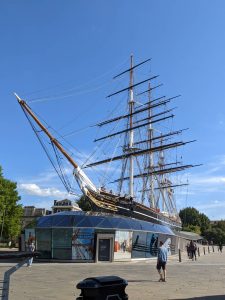 My final visit of the day was to the Cutty Sark, a nineteenth century tea clipper located in dry dock on the river bank. The Cutty Sark has a very sentimental place in my heart as it was a favourite place to visit as a child. We used to go to Greenwich a lot, getting the bus from Mile End and then walking through the Victorian foot tunnel under the river. I loved it there, the park and the eclectic market, the little shops, the Queen’s House and the Observatory, the graceful buildings of the Naval College. That much history in one place always set off my very eccentric imagination about the men and women who had lived in these buildings and walked these streets in the past. But the absolute joy for me was the once or twice a year when we were allowed to actually go aboard the Cutty Sark.
My final visit of the day was to the Cutty Sark, a nineteenth century tea clipper located in dry dock on the river bank. The Cutty Sark has a very sentimental place in my heart as it was a favourite place to visit as a child. We used to go to Greenwich a lot, getting the bus from Mile End and then walking through the Victorian foot tunnel under the river. I loved it there, the park and the eclectic market, the little shops, the Queen’s House and the Observatory, the graceful buildings of the Naval College. That much history in one place always set off my very eccentric imagination about the men and women who had lived in these buildings and walked these streets in the past. But the absolute joy for me was the once or twice a year when we were allowed to actually go aboard the Cutty Sark.
In those days, the Cutty Sark wasn’t the only ship on the riverside. She was joined by the Gypsy Moth IV, the yacht in which Sir Francis Chichester became the first person to single-handedly circumnavigate the globe in 1966. The yacht is now on display in the museum at Buckler’s Hard but I can remember visiting her at Greenwich. It was an exciting story and my sister, her interest firmly rooted in the present, loved it but it failed to catch my enthusiasm in the way that the clipper races of the Cutty Sark did.
I wasn’t sure that I’d still feel the same about the Cutty Sark. Certainly the displays aboard ship are very different to my childhood memories, probably because of the enormous amount of conservation work done over the years, especially after the fire of 2007. It’s astonishing that despite everything, 90% of the ship in Greenwich today is original. The ship you see today is mostly the same as when she first carried tea from Shanghai to London and was reopened by Her Majesty The Queen in 2012.
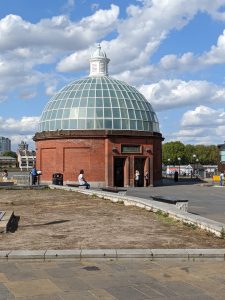
I was amused at how small the Cutty Sark felt to me, after recent visits to the Victory, the Trincomalee and the Warrior. Below decks had nothing like the atmosphere of the Napoleonic ships but once I was on deck again, I suddenly had that same feeling I remember in childhood, gazing awestruck up into her rigging, trying to imagine what it would have been like. The displays were fascinating and I’ve finally found out where the ship’s name came from. But for me, just standing there on the riverside, stepping onto the deck and then walking down into the old foot tunnel brought back memories so vivid I got quite emotional.
After a day on my feet, it was a relief to meet up with some of my fellow travellers at the Royal Horse Guards Hotel, and dinner was great fun. Today has been very restful, with a trip on the river and lunch at the Royal Opera House with Janet, one of my readers whom I’ve chatted to over the past couple of years and who I’ve been dying to meet. I think I’ve recuperated enough to hit the streets of London with Number One London Tours tomorrow to visit Waterloo related sights before heading off to Belgium the following day.
I’ll try to keep up these posts over the trip and share as many photos as I can, though it’s a packed programme so some of it will probably have to wait until I get home again. I’m hoping to learn a lot this week which will help me with the Waterloo book when I finally get to it. It’s getting alarmingly close…

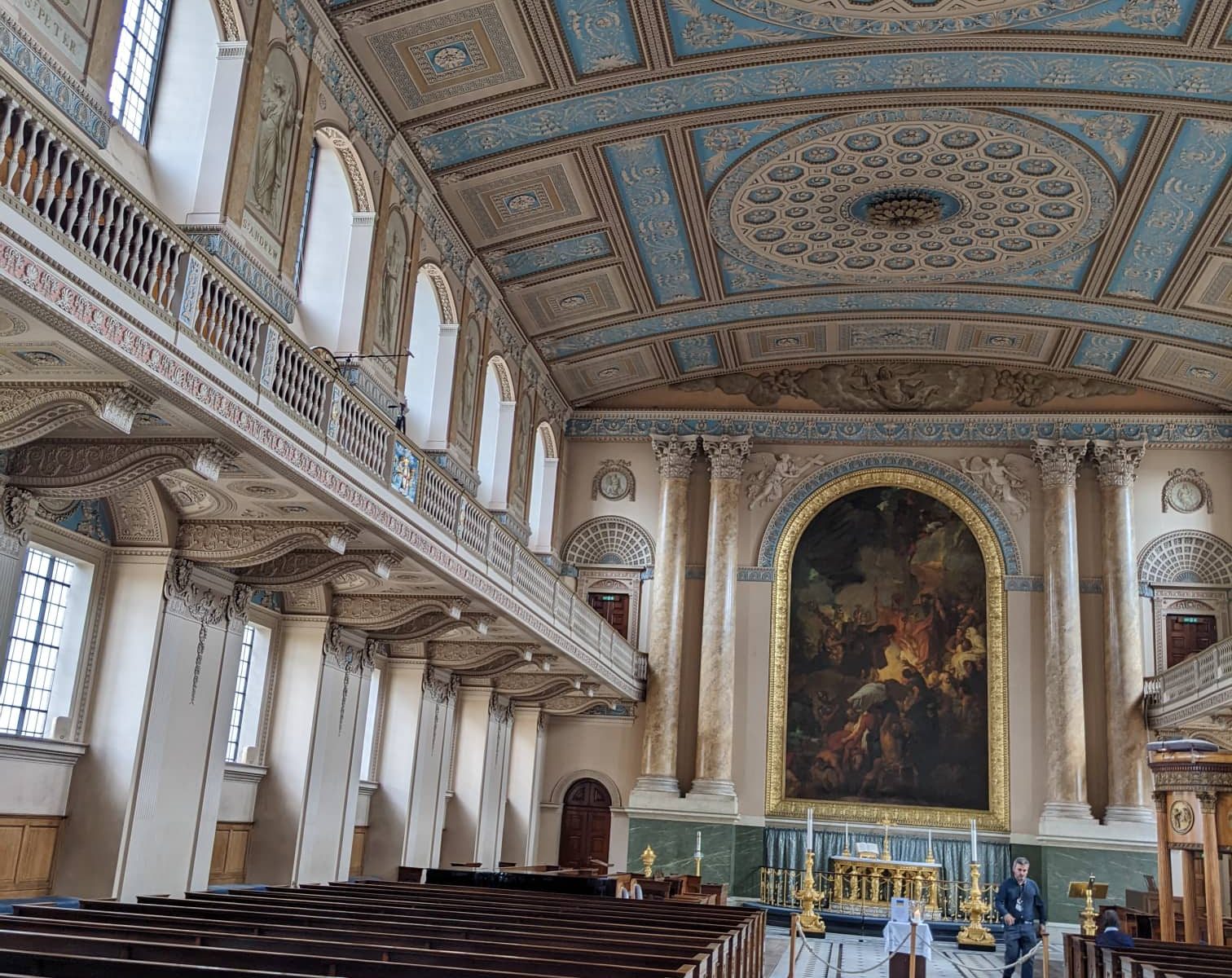
I’ve been to Buckler’s Hard, as it happens. My Mum’s old stamping ground.
Of course, it would be xx
Hi Lynn
I’m so envious of you. Back in 2012 I went back a 1000 years for a re-enactment show in Greenwich at St Alphege’s church which commemorated the death of you guessed it, St Alphege at the hands of those rotten Vikings.
After hours a few of us went to visit Cutty Sark and I remember being disappointed because I was expecting it to look like a longship, gawd knows why! Now I’d appreciate it more because of your books, though I know it was built later than the Napoleonic era, but it resonates more with me now.
Greenwich also played a part in the Scandinavian invasion of England in the early 11thc which you know is close to my heart. The rotten so and so’s kept a fleet of ships there for awhile which was on England’s side one minute and then the Danes the next!
Anyway loved reading your post!
I’m glad you enjoyed it. The Cutty Sark is lovely although I definitely identify more with the Napoleonic era ships like the Victory and the Trincomalee. And it seemed so small. I’m used to warships carrying hundreds of men…